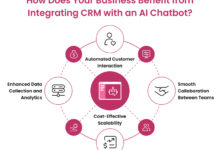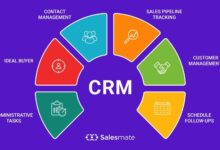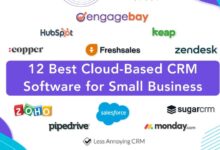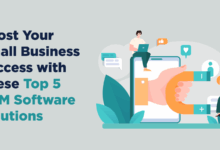Best Enterprise CRM Solutions: A Comprehensive Guide
Best Enterprise CRM Solutions are crucial for large organizations navigating the complexities of modern customer relationship management. This guide delves into the essential aspects of selecting, implementing, and leveraging enterprise-grade CRM systems, addressing the unique challenges faced by large businesses. We’ll explore key features, leading vendors, and future trends shaping the landscape of enterprise CRM, providing a practical framework for informed decision-making.
From defining your specific enterprise needs and comparing various deployment models to understanding the importance of integration, analytics, and robust security, we aim to equip you with the knowledge to choose the best solution for your organization. We’ll also examine successful case studies and explore the impact of emerging technologies like AI and machine learning on the future of enterprise CRM.
Defining Enterprise CRM Needs
Enterprise CRM systems are significantly different from those used by smaller businesses. The scale of operations, the complexity of customer interactions, and the sheer volume of data involved necessitate a robust and adaptable solution. Understanding these distinctions is crucial for selecting the right system.
The challenges faced by large organizations in managing customer relationships are multifaceted. Data silos across different departments, inconsistent customer experiences across various touchpoints, difficulty in gaining a unified view of the customer, and the need for advanced analytics to inform strategic decisions are just some of the obstacles. These challenges often lead to decreased efficiency, lost revenue opportunities, and damaged customer relationships.
Critical Functionalities of Enterprise CRM Systems
To effectively address the challenges faced by large organizations, enterprise CRM systems must incorporate several critical functionalities. These include comprehensive contact management capabilities, robust sales force automation tools, advanced marketing automation features, comprehensive customer service and support functionalities, and powerful reporting and analytics dashboards. These features, working in concert, enable organizations to gain a 360-degree view of their customers, streamline processes, and improve overall customer satisfaction. For example, integrated sales and marketing automation allows for personalized customer journeys, while advanced analytics provides insights into customer behavior, enabling data-driven decision-making. Furthermore, robust reporting capabilities allow for effective monitoring of key performance indicators (KPIs), such as customer acquisition cost and customer lifetime value.
Enterprise CRM Deployment Models: On-Premise vs. Cloud-Based
The choice between on-premise and cloud-based deployment significantly impacts an organization’s CRM strategy. Each model presents unique advantages and disadvantages concerning cost, scalability, and security.
| Model | Cost | Scalability | Security |
|---|---|---|---|
| On-Premise | High initial investment; ongoing maintenance and infrastructure costs. | Limited scalability; requires significant upfront planning and investment for future growth. | Requires robust internal security measures; responsibility lies solely with the organization. Potential for higher security risks due to on-site maintenance and access. |
| Cloud-Based | Lower initial investment; subscription-based pricing model; predictable operational costs. | Highly scalable; easily adaptable to changing business needs and growth; readily accessible resources. | Relies on the vendor’s security infrastructure; benefits from economies of scale in security measures. Potential for data breaches remains, but managed by the vendor. |
Top Enterprise CRM Solution Providers
Choosing the right Enterprise CRM is crucial for business success. The market offers a wide array of solutions, each with its own strengths and weaknesses. Selecting the optimal platform requires careful consideration of your specific business needs and operational requirements. This section will explore some of the leading providers and their offerings.
Leading Enterprise CRM Software Vendors
Several vendors dominate the enterprise CRM market, each offering a comprehensive suite of features designed to manage customer relationships across various business functions. These vendors continually adapt to evolving market demands, incorporating advancements in artificial intelligence, machine learning, and data analytics to enhance their platforms. Key players include Salesforce, Microsoft Dynamics 365, and SAP CRM. Other notable vendors offering robust enterprise solutions include Oracle Siebel, Adobe Experience Cloud, and Zoho CRM.
Comparison of Three Leading Vendors: Salesforce, Microsoft Dynamics 365, and SAP CRM
Salesforce, Microsoft Dynamics 365, and SAP CRM represent three leading contenders in the enterprise CRM space, each catering to different business needs and preferences.
Salesforce, known for its extensive AppExchange ecosystem and robust customization options, excels in providing highly adaptable solutions. Its strength lies in its flexibility and scalability, allowing businesses to tailor the platform to their specific workflows. However, its complexity can lead to higher implementation costs and a steeper learning curve.
Microsoft Dynamics 365 leverages Microsoft’s extensive ecosystem, integrating seamlessly with other Microsoft products like Office 365 and Power BI. This integration simplifies data management and reporting, making it a strong choice for businesses already invested in the Microsoft ecosystem. However, its customization options might be less extensive than Salesforce’s.
SAP CRM, a powerful solution particularly well-suited for large enterprises, offers comprehensive functionalities for managing complex sales processes and supply chains. Its strength lies in its robust capabilities for handling large datasets and integrating with existing SAP enterprise resource planning (ERP) systems. However, its high initial investment and complex implementation can be deterrents for smaller organizations.
Pricing Models of Leading Enterprise CRM Vendors
The pricing models for enterprise CRM solutions vary significantly, impacting the total cost of ownership. Understanding these models is essential for budgeting and selecting the most cost-effective option.
| Vendor | Pricing Model | Cost Range | Features Included |
|---|---|---|---|
| Salesforce | Subscription (per user, per month) | $25 – $300+ per user/month | Sales Cloud, Service Cloud, Marketing Cloud, etc. (features vary by edition) |
| Microsoft Dynamics 365 | Subscription (per user, per month) | $65 – $200+ per user/month | Sales, Customer Service, Marketing, Field Service, etc. (features vary by edition) |
| SAP CRM | Subscription (per user, per month); Perpetual License (one-time purchase) | Varies greatly depending on configuration and modules; typically high initial investment for perpetual licenses | Sales, Service, Marketing, Customer Relationship Management, etc. (highly configurable) |
Industries Served by Leading Enterprise CRM Vendors
Each vendor caters to a broad range of industries, but some demonstrate particular expertise in specific sectors.
Salesforce enjoys widespread adoption across numerous industries, particularly in sectors requiring high levels of customization and scalability, such as technology, finance, and healthcare.
Microsoft Dynamics 365 finds strong traction in industries heavily reliant on Microsoft’s ecosystem, such as retail, manufacturing, and professional services.
SAP CRM maintains a significant presence in large enterprises across diverse sectors, especially those requiring complex supply chain management and integration with existing SAP systems, such as manufacturing, automotive, and logistics.
Key Features and Functionality
A robust enterprise CRM system is more than just a contact list; it’s a dynamic engine driving sales, marketing, and customer service. Its effectiveness hinges on a powerful combination of key features and functionalities that seamlessly integrate to enhance efficiency and improve customer relationships. The following sections detail crucial aspects that contribute to a successful enterprise CRM implementation.
Integration Capabilities
Seamless integration is paramount for an enterprise CRM. Without it, data silos develop, hindering efficient workflow and creating inconsistencies. A well-integrated CRM connects with other vital business systems, such as marketing automation platforms, ERP systems, and e-commerce platforms. This interconnectedness allows for real-time data synchronization, eliminating manual data entry and ensuring all departments operate from a single source of truth. For example, integrating with a marketing automation platform allows for automated lead scoring and nurturing, while integration with an ERP system provides a complete view of customer transactions and order history. This holistic view enhances decision-making and improves overall business operations.
Advanced Analytics and Reporting
Advanced analytics and reporting capabilities transform raw data into actionable insights. Enterprise CRM systems should offer sophisticated reporting tools, allowing businesses to track key performance indicators (KPIs), analyze sales trends, and identify areas for improvement. Dashboards should provide a clear, concise overview of critical metrics, enabling proactive management and strategic decision-making. For instance, analyzing sales data can reveal which products are performing well and which require attention. Similarly, tracking customer engagement metrics can highlight areas needing improvement in customer service or marketing campaigns. Predictive analytics, a subset of advanced analytics, can even forecast future trends, allowing businesses to anticipate customer needs and adjust strategies accordingly. A company using predictive analytics might foresee a decline in sales for a specific product and proactively launch a marketing campaign to mitigate the potential loss.
Mobile Accessibility
In today’s mobile-first world, mobile accessibility is not a luxury but a necessity. A mobile-optimized CRM allows sales representatives, customer service agents, and marketing professionals to access and update customer information anytime, anywhere. This enhances productivity by allowing immediate responses to customer inquiries and faster deal closures. For example, a sales representative can access a customer’s complete history and past interactions directly from their smartphone during a meeting, enabling a more personalized and informed conversation. This real-time access improves customer engagement and fosters stronger relationships.
Robust Security Features
Protecting sensitive customer data is crucial for maintaining trust and complying with regulations like GDPR and CCPA. Enterprise CRM systems must incorporate robust security features, including data encryption, access controls, and regular security audits. Multi-factor authentication, strong password policies, and intrusion detection systems should be standard. Data breaches can severely damage a company’s reputation and lead to significant financial losses. Therefore, investing in a CRM with comprehensive security features is a critical aspect of protecting both customer data and the company’s bottom line. A robust security framework helps maintain customer confidence and ensures compliance with relevant data privacy regulations.
Implementation and Integration
Successfully implementing an enterprise CRM system requires careful planning and execution. A phased approach, coupled with robust change management strategies, is crucial for minimizing disruption and maximizing user adoption. This section details the key steps involved, common challenges, and best practices for a smooth transition.
Step-by-Step Implementation Guide
Implementing an enterprise CRM system is a multi-stage process. A well-defined plan, encompassing project scoping, data migration, system configuration, testing, and user training, is essential for a successful outcome. Each stage requires careful attention to detail and effective communication among stakeholders.
- Project Planning and Scoping: Define project goals, objectives, timelines, and resources. This includes identifying key stakeholders, establishing a project management methodology, and creating a detailed implementation plan.
- Data Migration: Cleanse, transform, and migrate existing customer data into the new CRM system. This often involves data mapping, validation, and reconciliation to ensure data integrity.
- System Configuration and Customization: Configure the CRM system to meet specific business requirements. This includes customizing workflows, dashboards, reports, and security settings.
- Testing and Quality Assurance: Thoroughly test the system to identify and resolve any bugs or issues before go-live. This includes unit testing, integration testing, and user acceptance testing.
- User Training and Adoption: Provide comprehensive training to end-users on how to effectively use the CRM system. This includes hands-on training, documentation, and ongoing support.
- Go-Live and Post-Implementation Support: Launch the CRM system and provide ongoing support to users. This includes monitoring system performance, addressing user issues, and making necessary adjustments.
Common Integration Challenges and Solutions
Integrating a new CRM system with existing enterprise applications can present significant challenges. These challenges often stem from data inconsistencies, incompatible systems, and a lack of clear integration strategies.
- Data Mapping and Transformation Issues: Discrepancies in data formats and structures between the CRM and other systems can lead to data loss or inaccuracies. Solution: Implement robust data mapping and transformation processes to ensure data consistency and accuracy.
- API Compatibility and Connectivity Problems: Incompatibilities between the CRM’s APIs and other systems can hinder seamless data exchange. Solution: Utilize appropriate integration technologies (e.g., APIs, ETL tools) and ensure compatibility between systems.
- Security and Access Control Issues: Integrating systems may introduce security vulnerabilities if not properly managed. Solution: Implement robust security protocols and access control mechanisms to protect sensitive data.
- Integration Complexity and Time Constraints: Integrating multiple systems can be complex and time-consuming, potentially delaying the project timeline. Solution: Employ a phased integration approach, prioritizing critical integrations first.
Best Practices for Data Migration and Data Integrity
Maintaining data integrity throughout the migration process is paramount. A well-defined data migration strategy, incorporating data cleansing, validation, and reconciliation, is essential.
Data cleansing involves identifying and correcting inaccurate, incomplete, or duplicate data. Data validation ensures that data meets specific quality standards before migration. Data reconciliation compares the data in the source and target systems to identify any discrepancies. Regular backups and version control are crucial for disaster recovery and data restoration.
Typical Workflow of an Enterprise CRM System
The following flowchart illustrates a simplified workflow, demonstrating how data flows through a typical enterprise CRM system. Note that the complexity of the workflow will vary depending on the specific CRM system and business processes.
[Imagine a flowchart here: The flowchart would start with a “Lead Generation” box, leading to “Lead Qualification” then “Opportunity Creation”. From “Opportunity Creation,” arrows would branch to “Sales Process Management” (leading to “Deal Closing” and then “Customer Onboarding”), and to “Customer Service Management” (leading to “Support Tickets” and then “Resolution”). All paths eventually converge into a “Customer Relationship Management” central box, which then feeds back into “Lead Generation” to start the cycle again. Each box would represent a key stage in the process, and the arrows would indicate the flow of data and activities.]
Future Trends in Enterprise CRM
The landscape of Enterprise CRM is constantly evolving, driven by technological advancements and shifting customer expectations. Understanding these future trends is crucial for businesses seeking to optimize their customer relationship management and gain a competitive edge. The integration of emerging technologies and a relentless focus on enhancing customer experience are defining the next generation of CRM solutions.
The Impact of Artificial Intelligence on Enterprise CRM Solutions
AI is rapidly transforming enterprise CRM, automating tasks, improving data analysis, and personalizing customer interactions. AI-powered chatbots provide instant customer support, handling routine inquiries and freeing up human agents to focus on more complex issues. Predictive analytics, driven by machine learning algorithms, analyze vast amounts of customer data to anticipate future behavior, enabling proactive engagement and personalized offers. For example, an e-commerce company might use AI to predict which customers are likely to churn and proactively offer them discounts or loyalty programs to retain their business. This proactive approach, powered by AI, significantly improves customer retention rates and overall business profitability.
Emerging Technologies Shaping the Future of CRM
Machine learning and automation are key technologies shaping the future of CRM. Machine learning algorithms continuously learn from data, improving their accuracy over time in tasks such as lead scoring, sales forecasting, and customer segmentation. Automation streamlines repetitive tasks, such as data entry and email marketing, freeing up valuable employee time for more strategic initiatives. Robotic Process Automation (RPA) can automate complex workflows, integrating with various systems to ensure seamless data flow and enhanced operational efficiency. Consider a large financial institution: RPA can automate the onboarding process for new clients, reducing processing time and improving accuracy, while machine learning can identify potential fraudulent transactions in real-time, minimizing financial risk.
The Role of Customer Experience (CX) Management in Enterprise CRM
Customer experience (CX) management is becoming increasingly central to enterprise CRM strategies. Businesses are realizing that providing exceptional CX is crucial for building brand loyalty, driving revenue growth, and achieving sustainable competitive advantage. Enterprise CRM systems are evolving to incorporate CX management features, enabling businesses to track customer interactions across multiple channels, personalize communications, and proactively address customer needs. For instance, a CRM system can track a customer’s interaction history across email, social media, and phone calls, providing a holistic view of their relationship with the company. This enables customer service representatives to personalize their interactions and provide more effective support.
A Hypothetical Next-Generation Enterprise CRM
A next-generation enterprise CRM would seamlessly integrate AI, machine learning, and automation to provide a truly holistic and intelligent customer view. It would go beyond simple data storage and retrieval, offering predictive insights, proactive customer engagement, and personalized experiences at scale. This system would leverage advanced analytics to identify and address customer pain points before they escalate, anticipating needs and providing solutions proactively. It would also incorporate advanced security features to protect sensitive customer data and ensure compliance with relevant regulations. Furthermore, such a system would be highly adaptable and scalable, capable of evolving with the changing needs of the business and its customers. Imagine a CRM system that can automatically adjust marketing campaigns based on real-time customer feedback, optimizing conversion rates and improving ROI. This represents a glimpse into the potential of a truly next-generation enterprise CRM.
Case Studies
Successful Enterprise CRM implementations demonstrate the transformative power of these systems in driving business growth and improving customer relationships. Examining real-world examples highlights the strategies employed to overcome challenges and achieve measurable improvements in key performance indicators. The following case studies illustrate the benefits and complexities involved in such projects.
Case Study 1: Salesforce Implementation at a Global Retail Chain
This global retail chain, with thousands of stores and millions of customers, faced challenges in managing customer data across various channels (online, in-store, and call center). Their existing systems were fragmented, leading to inconsistent customer experiences and difficulties in personalized marketing. They chose Salesforce Sales Cloud and Service Cloud to consolidate their customer data, improve sales processes, and enhance customer service. The implementation involved a phased rollout, starting with a pilot program in a select group of stores. Significant challenges included data migration, user training, and integrating the new system with existing legacy systems. Strategies to address these challenges included establishing a dedicated project team, developing a comprehensive training program, and utilizing data cleansing tools. The result was a unified view of the customer, improved sales conversion rates by 15%, a 20% increase in customer satisfaction scores, and a significant reduction in customer service response times.
Case Study 2: Microsoft Dynamics 365 Implementation at a Pharmaceutical Company
A large pharmaceutical company implemented Microsoft Dynamics 365 to streamline its sales and marketing processes, improve field force effectiveness, and enhance regulatory compliance. Prior to implementation, the company relied on disparate systems for managing customer interactions, sales leads, and regulatory information. This resulted in inefficiencies and difficulties in tracking key performance indicators. The implementation involved customizing Dynamics 365 to meet the specific needs of the pharmaceutical industry, including integrating with regulatory compliance systems. Key challenges included data integration from legacy systems, training sales representatives on the new platform, and ensuring data security and compliance. The strategies employed to overcome these challenges included thorough data mapping, creating user-friendly training materials, and implementing robust security protocols. The measurable impact of the implementation included a 10% increase in sales productivity, improved forecasting accuracy, and enhanced regulatory compliance, minimizing the risk of non-compliance penalties.
Key Lessons Learned
The success of these implementations highlights several key lessons:
- Thorough planning and project management are crucial. A well-defined project plan with clear timelines and responsibilities is essential for success.
- Data migration and cleansing are critical steps. Poor data quality can significantly impact the effectiveness of the CRM system.
- Comprehensive user training is essential for adoption. Users need to be adequately trained to utilize the system effectively.
- Integration with existing systems is important. The CRM system should seamlessly integrate with other business systems to avoid data silos.
- Continuous monitoring and improvement are necessary. Regularly assess the effectiveness of the CRM system and make adjustments as needed.
Conclusive Thoughts
Ultimately, selecting the right enterprise CRM solution is a strategic decision that requires careful consideration of your organization’s unique requirements and long-term goals. By understanding the key features, implementation challenges, and future trends discussed in this guide, businesses can make informed choices that optimize customer relationships, improve operational efficiency, and drive significant business growth. The successful implementation of an enterprise CRM system requires a holistic approach, encompassing thorough planning, effective integration, and ongoing optimization to maximize its potential.





